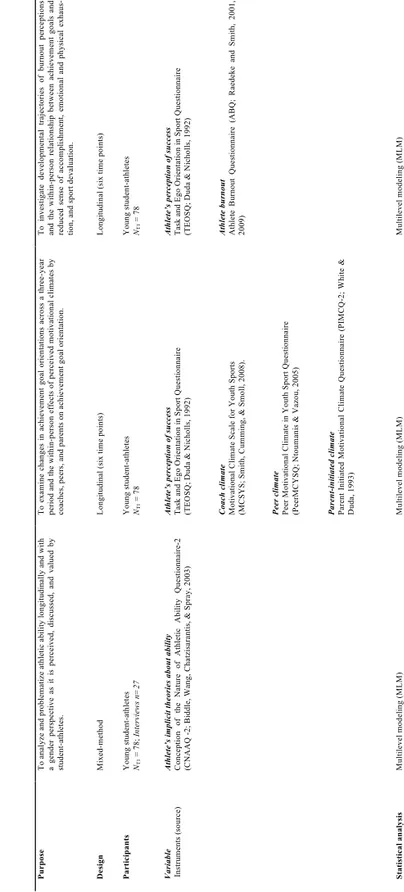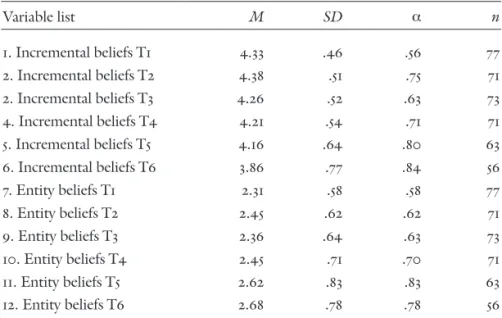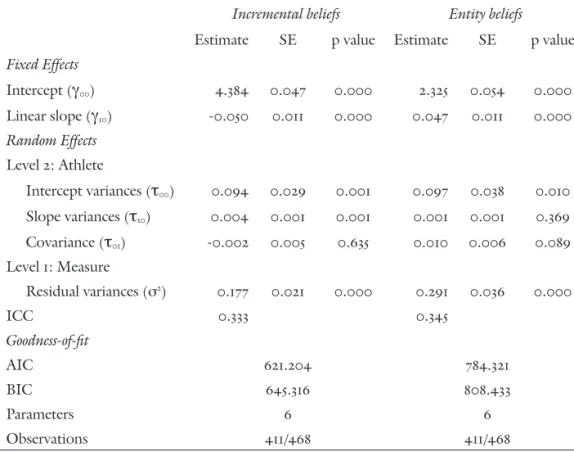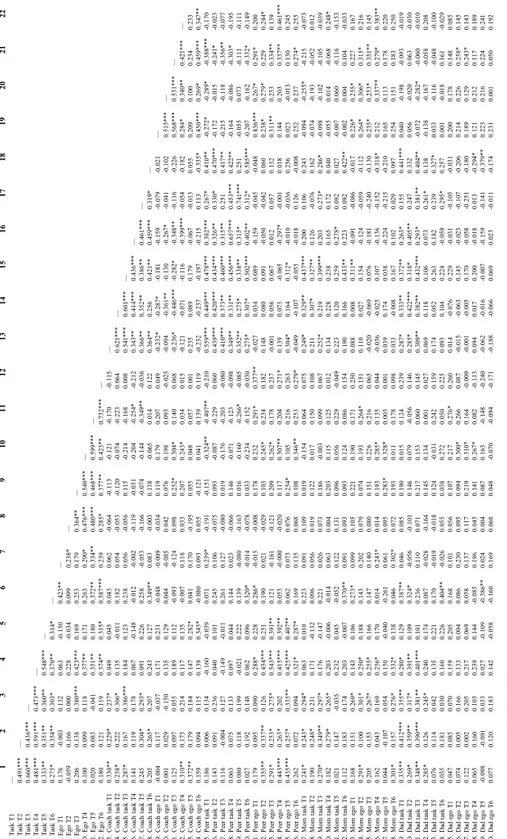MALMÖ S TUDIES IN SPORT SCIEN CES V OL 32 JO AKIM IN GRELL MALMÖ UNIVERSIT
WHA
T
DOES
IT
TAKE
T
O
BE
SUCCESSFUL
HERE?
JOAKIM INGRELL
WHAT DOES IT TAKE TO BE
SUCCESSFUL HERE?
A longitudinal study of achievement motivation
in youth sport
Malmö Studies in Sport Sciences Vol 32
© Copyright Joakim Ingrell Omslag Kim Berkhuizen ISBN 978-91-7877-007-6 (print) ISBN 978-91-7877-008-3 (pdf) ISSN 1652-3180
Malmö University, 2019
Faculty of Education and Society
JOAKIM INGRELL
WHAT DOES IT TAKE TO
BE SUCCESSFUL HERE?
A longitudinal study of achievement motivation in
youth sport
Publikationen finns även elektroniskt, se muep.mau.se
ABSTRACT
The focal aim of this dissertation project centers on understanding the
importance of some of the underlying factors responsible for the
sociali-zation of achievement motivation in youth sport and its affective
out-comes. Furthermore, this dissertation project focuses on the specializing
stage of development, more specifically, student-athletes (N = 78)
at-tending a compulsory school with a sports profile.
This dissertation project was guided by the theoretical frameworks
provided by achievement goal theory (Nicholls, 1984, 1989), implicit
theories of ability (Dweck, 2000), Ames’ (1992a, 1992b) motivational
climate, Big-Fish-Little-Pond Effect (Marsh, 1984; Marsh & Parker,
1984) athletic burnout (Raedeke & Smith, 2001), and gender as a social
institution (Lorber, 1994).
In the first study, the aim was to analyze and problematize athletic
ability longitudinally and with a gender perspective as it is perceived,
discussed, and valued by student-athletes. A mixed method approach
was used in this study consisting of quantitative analysis (multilevel
modeling) of a three-year, six-wave data collection (N = 78).
Further-more, semi-structured interviews were conducted with 27 of the
student-athletes. The two main results of this study were that entity beliefs
in-creased, and incremental beliefs decreased during the three-year period,
and that gender added a further understanding of the beliefs of
student-athletes regarding athletic ability.
The second study aimed to examine achievement goals in youth sport
longitudinally and the within-person effects of perceived motivational
climates by coaches, peers, and parents on achievement goal
orienta-tions. The student-athletes (N = 78) completed a multi-section
question-naire, six times over a three-year period, assessing the study variables
and the multilevel modeling analysis revealed that both the task
orienta-tion and the ego orientaorienta-tion decreased for this age group over the
three-year period. Furthermore, the perceived task involving peer climate was
significantly and positively related to task orientation, and perceived
ego-involving coaching climate was significantly and positively related
to ego orientation.
In the third study, the aim was to examine the developmental
trajecto-ries of student-athlete burnout perceptions and the within-person
rela-tionship between achievement goals and burnout perceptions. The
par-ticipants (N = 78), time frame, and measurement points were the same in
this study, as in studies I and II. The results from the multilevel growth
models revealed that burnout perceptions increased for this age group
over the three-year period. Furthermore, task orientation was
signifi-cantly and negatively related to a reduced sense of accomplishment and
sport devaluation.
The findings from this dissertation project highlight some of the
com-plexity of achievement motivation in youth sport; the relationships
be-tween this type of motivation and the context, in this case, a school with
a sports profile, and organized sports, and significant others such as
coaches, peers, and parents. Furthermore, the results from this
disserta-tion project underline the advantage of considering a specific
develop-mental stage when studying achievement motivation in youth sport
lon-gitudinally.
SWEDISH SUMMARY
Syftet med detta avhandlingsprojekt var att förstå vikten av några av de
bakomliggande faktorer som kan tänkas vara ansvariga för
sociali-seringen av prestationsmotivation inom ungdomsidrotten samt dess
af-fektiva konsekvenser. Vidare fokuserade detta avhandlingsprojekt på det
specialiserande karriärstadiet, mer specifikt elever (N = 78) som gick i
en idrottsprofilerad grundskola.
Avhandlingens teoretiska ramverk var: målorienteringsteorin
(Nicholls, 1984, 1989), ”mindsets” (Dweck, 2000), motivationsklimat
(Ames, 1992a, 1992b), Big Fish-Little-Pond Effect (Marsh, 1984;
Marsh & Parker, 1984) idrottslig utbrändhet (Raedeke & Smith, 2001)
och kön som social konstruktion (Lorber, 1994).
I den första studien var syftet att analysera och problematisera
idrotts-lig förmåga, longitudinellt och med ett genusperspektiv, utifrån hur det
uppfattades, diskuterades och värderades av de idrottande eleverna. En
kombination av kvantitativa och kvalitativa metoder användes i denna
studie bestående av en kvantitativ analys av en treårig datainsamling (N
= 78) samt semistrukturerade intervjuer med 27 av de idrottande
elever-na. De två huvudsakliga resultaten var att synen på idrottslig förmåga
som statisk, icke kontrollerbar och nedärvd ökade medan synen på
id-rottslig förmåga som förändringsbar, utvecklingsbar och kontrollerbar
minskade. Vidare gav genusperspektivet en ytterligare förståelse för
elevernas föreställningar gällande idrottslig förmåga.
Syftet med den andra studien var att undersöka unga idrottares
målo-rientering över tid samt relationen mellan målomålo-rienteringar och det
upp-levda motivationsklimatet, skapat av tränare, föräldrar och kamrater.
Id-rottande elever (N = 78) svarade på flertalet enkäter, sex gånger över en
treårsperiod, och den statistiska analysen visade att både
uppgiftsorien-tering och egoorienuppgiftsorien-tering minskade för denna åldersgrupp. Ett
uppgifts-orienterat kamratklimat var statistiskt signifikant och positivt relaterat
till uppgiftsorientering. Resultatet visade också att upplevt egoorienterat
tränarklimat var statistiskt signifikant och positivt relaterat till
egoorien-tering.
I den tredje studien var syftet att undersöka idrottande elevers
ut-vecklingskurvor gällande idrottslig utbrändhet i form av emotionell och
fysisk utmattning, reducerad syn på idrottskompetens och nedvärdering
av idrottens betydelse samt relationen mellan målorienteringar och de
tre variablerna kopplade till idrottslig utbrändhet. Deltagarna (N = 78),
tidsramen och mätpunkterna var desamma i den här studien som i studie
I och studie II. Resultaten visade att idrottslig utbrändhet ökade under
treårsperioden. Dessutom var uppgiftsorienteringen statistiskt
signifi-kant och negativt relaterad till reducerad syn på idrottskompetens och
nedvärdering av idrottens betydelse.
Detta avhandlingsprojekt lyfter fram en del av komplexiteten gällande
prestationsmotivation inom ungdomsidrotten, relationerna mellan denna
typ av motivation och kontexten, i detta fall en idrottsprofilerad
grund-skola, organiserade idrott samt betydelsefulla skapare av
motivations-klimatet som tränare, kamrater och föräldrar. Vidare understryker
resul-taten från detta avhandlingsprojekt fördelen av att överväga ett specifikt
utvecklingsstadium vid longitudinella studier av prestationsmotivation
inom ungdomsidrotten.
LIST OF SCIENTIFIC PAPERS
The present doctoral dissertation is based on the following three studies:
Article I
Ingrell, J., Larneby, M., Johnson, U., & Hedenborg, S. (2019).
Student-athletes’ beliefs about athletic ability: A longitudinal and mixed method
gender study. Scandinavian Sport Studies Forum, 10, 117-138
Article II
Ingrell, J., Johnson, U., & Ivarsson, A. (2019). Achievement goals in
youth sport and the influence of coaches, peers, and parent: a
longitudi-nal study. Manuscript submitted for publication
Article III
Ingrell, J., Johnson, U., & Ivarsson, A. (2018). Developmental changes
in burnout perceptions among student-athletes: An achievement goal
perspective. International Journal of Sport and Exercise Psychology,
doi:10.1080/1612197X.2017.1421679
CONTENTS
ABSTRACT ... 7
SWEDISH SUMMARY ... 9
LIST OF SCIENTIFIC PAPERS ... 11
Article I ... 11
Article II ... 11
Article III ... 11
ACKNOWLEDGMENTS ... 15
INTRODUCTION ... 19
THEORETICAL FRAMEWORKS ... 21
Achievement motivational theories ... 21
Achievement goal theory ... 21
Implicit theories of ability ... 25
Motivational climate ... 26
Longitudinal studies ... 31
Big-Fish-Little-Pond Effect ... 33
Athletic burnout ... 35
Gender as a social institution ... 36
Why the theoretical frameworks? ... 39
AIMS FOR THE DISSERTATION ... 42
MATERIAL AND METHODS ... 43
Ethical considerations ... 43
Mixed method ... 45
Samples and procedures ... 52
Measures ... 54
THE EMPIRICAL STUDIES ... 58
Study 1: Student-athletes’ beliefs about athletic ability: A longitudinal and mixed method gender study ... 58
Background and aim ... 58
Method ... 59
Results and discussion ... 59
Study 2: Achievement goals in youth sport and the influence of coaches, peers, and parents: a longitudinal study ... 62
Background and aim ... 62
Method ... 63
Results and discussion ... 63
Study 3: Developmental changes in burnout perceptions among student-athletes: An achievement goal perspective ... 64
Background and aim ... 64
Method ... 65
Results and discussion ... 65
GENERAL DISCUSSION ... 67
Limitations and suggestions for future research ... 73
REFERENCES ... 76
ACKNOWLEDGMENTS
Finally!
Writing a dissertation is a lonely and anguished journey, and now that
I have arrived at the finish line, I want to begin this chapter by patting
myself on the shoulder. However, I doubt that I could have done it
with-out help and support from the people around me.
To my main supervisor, Urban Johnson, it has been great to have you
on my journey from the start at Halmstad University in 2003 to the
completion of this dissertation. I am very grateful for the way you have
approached me and my thoughts with empathy and professionalism.
Although there has been a geographical distance between us, you have
always been close at hand to give constructive feedback when I needed
it.
To my other supervisor, Tomas Peterson, I want to say thank you for
your autonomy support. Also, I want to thank you for making me, as a
sport psychologist, feel included at the Department of Sport Sciences.
I also want to take this opportunity to thank Andreas Ivarsson. You
were always there when needed to guide me through the tricky but
in-teresting world of statistics.
To the principal, teachers, and most of all, the student-athletes at the
sports school, without you, there would not be any dissertation. Thanks
for contributing!
The colleagues at the Department of Sport Sciences should have a big
thank you! Over the years, I have been involved in interesting
collabora-tions, a special thanks here to Sverker Fryklund, Torsten Buhre, Jenny
Vikman, and Mats Johnsson.
Another colleague, a fellow doctoral researcher, and friend, Marie
Larneby, should have a big thank you. We have participated in the same
research project, supported each other both inside and outside of work,
which has led to a friendship I truly treasure.
For me, the climate is very important, within sports or work. Some
people who meant a lot to the working climate and who I want to thank
are Emelie Niléhn, Björn Hansson, and Annika Larsson.
I would also like to thank the present and former doctoral students Jens
Alm, Jyri Backman, Anna Bergenfeldt Fabri, Daniel Bjärsholm, Sepand
Mashreghi Blank, Niklas Hafen, Anna-Maria Hellborg, Alexander
Jans-son, Kalle JonasJans-son, Isak Lidström, Matilda Lindberg, Mattias
Melkers-son, Julia Rönnbäck, Sofia Sebelius, Marit Stub Nybelius, and Joakim
Åkesson. There are many memories, but it is the little things that stick
with you, such as a nice cup of coffee or hilarious lunches.
I would also like to thank Magnus Lindwall for the inspirational
versation we had during my 90% seminar. I appreciate how you
con-ducted the seminar, and your comments, that took the work forward.
I would also like to thank Susanna Hedenborg for being the senior
re-searcher at the department who gave comments on my manuscript after
the 90% seminar. Furthermore, you have contributed to many interesting
learning activities during my time as a doctoral student.
During my time at the Department of Sport Science, the department
has been run by three individuals who all, in different ways, have been
meaningful to me.
To Aage Radmann, I would like to say thanks for always supporting
me, reinforcing what I did well, and constructively correcting me when
needed.
To Kristian Sjövik, thank you for giving me the opportunity to follow
my heart and be able to move to Stockholm for a while for me to carry
out my commitments from a distance.
Related to this, I would also like to thank Liselotte Ohlson at the
Swedish Sports Confederation for creating both a physical place for me
to sit in and a context for me to grow in during my time in Stockholm.
A big thank you also to Torun Mattson, who went seamlessly from
being a fellow doctoral researcher to becoming our new head of
depart-ment. Thank you for listening to all aspects of me.
My family in Landskrona, Glumslöv, Uddevalla, and Malmö should
have a big thank you for all the love and support. You are absolutely
fantastic! An extra big thank you goes to my mother, who has always
been there.
What would life be without friends? Two friends I especially want to
thank are Michael and Kim. Thanks for being there even when the
geo-graphical distance between us was big and/or when the time apart has
been too long. I would also like to thank Kim for allowing me to use one
of his works, Urban Abstract III, as a motive for the cover of this
disser-tation. I thought this work represented the dissertation's content
brilliant-ly. The growth curves in this dissertation are linear, but if you tear off
the surface, the chaos representing adolescence is revealed.
Also, a shout out to all involved in the yearly, and legendary, crayfish
party. I hope you all know what you mean to me!
I am saving the best for last.
Moa, the love of my life, no words can describe how thankful I am. I
am still amazed at how much love, strength, and wisdom you have. You
were my rock when I was low, but more importantly, you threw yourself
around me and celebrated together with me in moments of success. I
love you and treasure everything we have.
Hilda, my wonderful daughter, oh, how I love you. I will always let
you know, but still, if you ever open up this page, I want you to read
about how you have contributed to this dissertation far beyond what you
ever can comprehend. Being mindful with your curiosity in play, when
you master new skills, and soaking up every laugh you provide has been
a “happy place” necessary for me to go on.
To My, you are one week old when writing this, but I have a lifetime
of love for you.
Joakim Ingrell
INTRODUCTION
Millions of young people participate in organized sport and as argued by
many researcher (e.g., Bangsbo et al., 2016; Støckel, Strandbu, Solenes,
Jørgensen, & Fransson, 2010; Zaff, Moore, Papillo, & Williams, 2003),
children’s early involvement in organized sport is often considered to be a
key opportunity for the development of movement skills, social skills,
self-esteem, and the maintenance of health through physical activity.
However, whether such outcomes are realized could to a large extent be
dependent on the type of influence exerted by social-environmental
fac-tors during these influential formative years (Bélanger et al., 2015;
Wagnsson, 2009). Statistics from the Swedish sports confederation
(Sports in numbers, 2017) show that between the years 2014-2015
ap-proximately 70% of all children between 12-15 years old in Sweden
par-ticipated in organized sport at least one day a week. Because the sports
environment is inherently a competence and achievement context (Støckel
et al., 2010), motivational factors play an important role. Although
im-portant aspects of individuals’ motivations are determined by their own
beliefs, cognitions, and values (Nicholls, 1989), significant influences can
also be exerted by key social agents like coaches, peers, and parents
(Ames, 1992a, 1992b). These three social agents are perhaps the most
consistent and reliable sources of influence across the athlete’s sporting
experience. About athletes sporting experience, models of athletic career
progression have been proposed by both Côté, Baker, and Abernethy
(2003) and Wylleman, Alfermann, and Lavallee (2004). The
initia-tion/sampling stage refers the early career and is characterized by
partici-pants who are generally prompted to try several different sports to see if
they either enjoy them, have some talent, or perhaps both (Côté al., 2003;
Wylleman et al., 2004). Following this period, athletes tend to focus on
one or two sports in which they specialize, learning the key skills, tactics,
and rules. This specializing phase tends to occur from around the age of
11–12 years. The next developmental stage is termed the
invest-ment/mastery stage (Côté al., 2003; Wylleman et al., 2004) and begins
from approximately 15 years of age, depending on the sport. The
invest-ment/mastery stage is defined by a heavy and exclusive focus on
deliber-ate practice, specialist coaching in a single sport, and markedly decreased
parental involvement (Côté et al., 2003). In contrast, it is hard to delineate
the specializing career stage because it is characterized by change. These
changes include (a) decreasing number of sports/activities; (b) a decrease
in deliberate play, being replaced with deliberate practice, and (c) gradual
changes in the roles of coaches (from “helper” to “specialist”), parents
(from direct to indirect involvement), and peers (from
stimulation/co-participation towards the fulfillment of emotional needs) (Côté et al.,
2003). The final stage is called recreational (Côté al., 2003) or
discontinu-ation (Wylleman et al., 2004) and during this period, athletes stop
partici-pating in competitions on the level they had previously achieved but may
continue training for recreational purposes.
This dissertation project is part of an interdisciplinary research project
with the overall purpose of studying the sociological, physiological, and
psychological factors that could potentially affect continuous and/or
successful participation in sports. Furthermore, this dissertation project
focuses on the specializing stage of development, more specifically,
stu-dent-athletes attending a compulsory school with a sports profile. As
de-scribed above, children and young adolescents in the specializing stage
are argued to be influenced by socio-environmental factors that
poten-tially change during this meaningful time period. Hence, this
disserta-tion project has a longitudinal focus on the achievement motivadisserta-tion of
young student-athletes regarding their participation in sport. The focal
aim of this dissertation project, therefore, centers on understanding the
importance of some of the underlying factors responsible for the
sociali-zation of achievement motivation in youth sport and its affective
out-comes. Furthermore, when studying the social influence on these young
student-athletes achievement motivations, I am examining the reasons
behind the motivated actions and how coaches, parents, and peers
influ-ence these reasons over time.
THEORETICAL FRAMEWORKS
The foundation for this dissertation project rests upon the theoretical
frameworks used as the lenses through which the research problems and
research questions are being evaluated. Those frameworks are:
achieve-ment goal theory (Nicholls, 1984, 1989), implicit theories of ability
(Dweck, 2000), Ames’ (1992a, 1992b) motivational climate,
Big-Fish-Little-Pond Effect (Marsh, 1984; Marsh & Parker, 1984), athletic
burn-out (Raedeke & Smith, 2001), and gender as a social institution
(Lorber, 1994). These theoretical frameworks will be described in more
detail below.
Achievement motivational theories
The theories regarding achievement goals were developed in the early
1980s by, for example, John Nicholls (1984), Carole Ames and Russel
Ames (1984), and Carol Dweck (1986). Each of these theorists has
dis-tinguished between two distinct goals for achievement behavior and
have also offered similar enough conceptualizations to be referred to
to-gether as “the dichotomous achievement goal model.” In this model,
achievement goal is defined as the purpose of engaging in achievement
behavior (Maehr, 1989).
Achievement goal theory
Achievement goal theory (AGT) is a social-cognitive theory that
as-sumes that the individual is an intentional, rational, goal-directed
organ-ism and that achievement goals govern achievement beliefs and guide
subsequent decision making and behavior in achievement contexts. In
developing AGT, Nicholls (1984, 1989) claimed that a person’s internal
sense of ability was a main achievement motive but proposed that in
achievement contexts, ability could be construed in two different
man-ners specifying the goals (purposes or reasons) that direct
achievement-related behaviors. Nicholls (1984) stated:
Achievement behavior is defined as behavior directed at developing or demonstrating high rather than low ability. It is shown that ability can be conceived in two ways. First, ability can be judged high or low with reference to the individual’s own past performance or knowledge. In this context, gains in mastery indicate competence, second, ability can be judged as capacity relative to that of others. In this context, a gain in mastery alone does not indicate high ability. To demonstrate high capacity, one must achieve more with equal ef-fort or use less efef-fort than do others for an equal performance. (Nicholls, 1984, p. 328)






